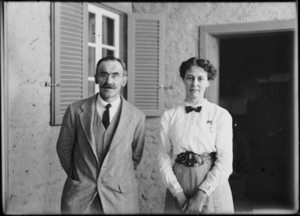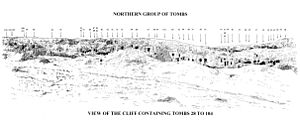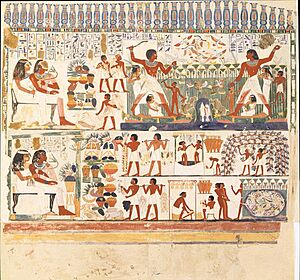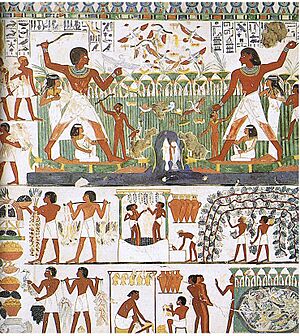N. de Garis Davies facts for kids
Nina M. Davies (born January 6, 1881 – died April 21, 1965) and Norman de Garis Davies (born 1865 – died November 5, 1941) were a married couple who were expert illustrators. They worked in Egypt during the early and mid-1900s. Their job was to draw and record ancient paintings found in Egyptian tombs. Their work was often published together under the name N. de Garis Davies. This makes it hard to tell who drew which picture! They helped us learn a lot about ancient Egypt through their amazing artwork.
Contents
Nina's Early Life and Art Skills
Nina M. Davies was born Anna Macpherson Cummings in Salonika, Greece. She was the oldest of three daughters. After her father passed away in 1894, she moved back to Scotland. Nina's family was from England and Scotland. She went to school in England and showed a lot of talent for art when she was young. Her family even moved to London so she could get special art training.
In 1906, Nina was on vacation in Alexandria, Egypt. That's where she met Norman de Garis Davies. They got married in Hampstead, London, on October 8, 1907. After marrying, they settled near the Theban Necropolis in Egypt. This was a famous burial ground. They started documenting the beautiful paintings found inside the ancient tombs there. Nina became very good at quickly and accurately drawing these images. She made many copies of the tomb paintings for different museums.
Norman's Journey to Egyptology
Norman de Garis Davies first studied religion at Glasgow University. He earned a Master of Arts and a Bachelor of Divinity degree. He also studied more at Marburg University. He was a minister in a church when he first visited Egypt in 1897. While there, he worked with a famous archaeologist named Flinders Petrie at a place called Dendera.
Later, Norman became the head of the Archaeological Survey for the Egypt Exploration Society. From about 1898 to 1907, Norman carefully recorded tombs all over Egypt, including at Tell el-Amarna. He became an expert at understanding the ancient Egyptian hieroglyphics (picture writing) within the tomb paintings. This skill was very important for their work.
Drawing Ancient Egyptian Art
In 1907, the Metropolitan Museum of Art in New York started an Egyptian Expedition. Their goal was to make exact copies of Egyptian wall paintings. Norman, Nina, and other artists used a special tracing method. This allowed them to copy almost every brushstroke and color perfectly. Most of the time, their copies showed the scene exactly as it was, even if it had been damaged over time. Sometimes, they drew the pictures to look like they did thousands of years ago when they were first made.
Norman led this special drawing effort. He had two main jobs: understanding the hieroglyphs and copying the images. The artists would sign their work. Nina often signed as Na.deGD, and Norman signed as No.deGD. Sometimes, they just signed NdeGD, making it hard to know if Nina or Norman did the drawing.
The tombs they worked on were located on the west bank of the Nile River in western Thebes. The museum was especially interested in the tombs of important officials, the royal tombs in the Valley of the Kings and Valley of the Queens, and the tombs of artists in Deir el-Medina. These places are known as the richest source of ancient Egyptian paintings anywhere in Egypt.
The images in the tombs changed over time, showing different periods of Egyptian history. They give us clues about daily life, the plants and animals, and the special customs for ceremonies and burials. The artistic styles also changed. By 1941, they had painted about 350 copies. These copies are now important displays in the Met's Egyptian department.
Nina and Norman also worked for other groups, like the Egypt Exploration Society in London and the University of Chicago Oriental Institute in Chicago. They documented other Egyptian sites, such as Abydos and Amarna. In 1939, they returned to England. Norman passed away two years later. Nina lived until 1965.
Where to See Their Work
Many of their amazing drawings are now in museums around the world.
- The Metropolitan Museum of Art in New York has over 400 items by the de Garis Davies couple.
- Nina de Garis Davies, Netting Birds, Tomb of Khnumhotep, Egypt, about 1897–1878 B.C.
- Nina de Garis Davies, Sculptors at Work, Tomb of Rekhmire (TT 100), Egypt, about 1479–1425 B.C.
- Norman de Garis Davies, Leaders of a Group of Asiatics, Egypt, about 1887–1878 B.C.
- The British Museum in London also has many of Nina de Garis Davies' paintings.
- Nina de Garis Davies, Fig gatherers with baboons in the trees from the tomb of Khnumhotep II.
- Nina de Garis Davies, Goldsmiths and Joiners.





